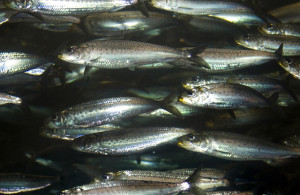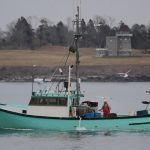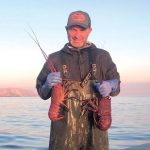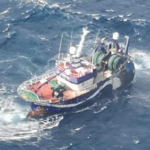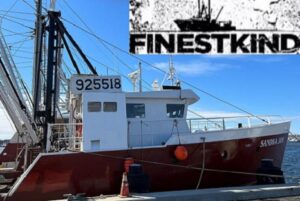Tag Archives: Rainbow smelt
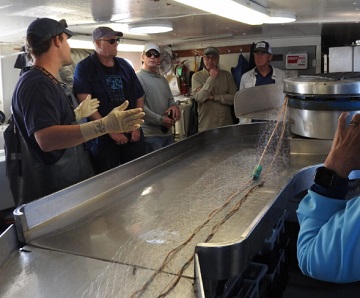
Natural Connections: The Lake Superior Fishery in Wisconsin Waters
The boat engine rumbled and machinery whirred as a gillnet rose from the depths of Lake Superior. Captain Ross Lind managed the throttle so that the 55-foot-long gillnet-tug-turned-research-vessel named Hack Noyes moved toward the net at the same speed the net lifter reeled it in. A group of interested adults on this Museum-sponsored field trip gathered around the equipment. We were mesmerized by the clicking of the metal teeth on the spinning drum as they gripped and then released the line, and by the lengths of delicate nylon net attached to the line. Capable hands guided the net down a long, stainless-steel worktable and into the storage tub. (Check 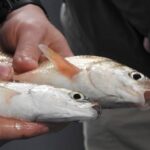 out the Museum’s Reels on Instagram and Facebook if you want to see a video of this operation.) Gillnets look like a long tennis net, anchored by weights along the lake bottom and held vertical by floats. Small fish swim right through, but bigger fish get caught. Whether a DNR biologist or a commercial fisherman is setting the net, they can choose the fish they target by the size of the mesh and the depth of set. >click to read< 19:28
out the Museum’s Reels on Instagram and Facebook if you want to see a video of this operation.) Gillnets look like a long tennis net, anchored by weights along the lake bottom and held vertical by floats. Small fish swim right through, but bigger fish get caught. Whether a DNR biologist or a commercial fisherman is setting the net, they can choose the fish they target by the size of the mesh and the depth of set. >click to read< 19:28

What Happens When Humans Fall In Love With An Invasive Species
Some people miss the glory days of Lester River fishing even when evidence suggests that Lake Superior and the people who rely on it are better off now. Facts, it turns out, can’t always sway emotion or reshape business plans. And these issues are not unique to smelt. All over the world, you’ll find invasive species that are beloved by humans — even as these foreign plants and animals alter or damage the environment. The fight against invasive species is often framed as a technological problem — how do you selectively eliminate a species once it’s made itself at home in an environment? But in reality, it’s also a question of human hearts and minds. And those might be the harder obstacle to clear. >click to read<19:00
Smeltdown: Small fish continues Great Lakes vanishing act
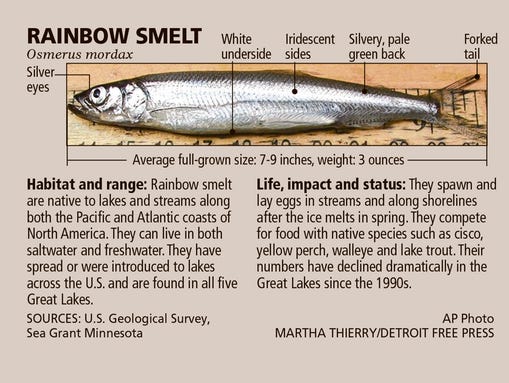
Like so many fish people associate with the Great Lakes, the rainbow smelt is an invasive species. The approximately 6-inch fish is native to the Atlantic and Pacific oceans, but moves into freshwater to spawn. It was first stocked in Crystal Lake in Benzie County in 1912, after several unsuccessful attempts to stock smelt in the St. Mary’s River to support another transplanted fish, Atlantic salmon. Smelt were found in Lake Michigan in 1923 and then spread throughout the Great Lakes. The commercial harvest of smelt on the Great Lakes reached 4.8 million pounds by 1941. Read the rest here 10:03
Kennebec Journal: OUR OPINION: We need answer to smelt decline before it’s too late
 Rainbow smelt were once found as far south as Chesapeake Bay, and were particularly abundant along the Gulf of Maine. Now, the small, tasty fish has disappeared from Connecticut south, in a depopulation so rapid that researchers were too late to pinpoint an exact cause. A similar trend is occurring in Maine, where the smelt numbers are dropping around Kennebec County and southern Maine. Their decline could be a sign that something is wrong with the water, Read more here 03:33
Rainbow smelt were once found as far south as Chesapeake Bay, and were particularly abundant along the Gulf of Maine. Now, the small, tasty fish has disappeared from Connecticut south, in a depopulation so rapid that researchers were too late to pinpoint an exact cause. A similar trend is occurring in Maine, where the smelt numbers are dropping around Kennebec County and southern Maine. Their decline could be a sign that something is wrong with the water, Read more here 03:33
Deep freeze good news for Maine smelt fishing camps – Ice on rivers comes sooner than it has for quite a few years, allowing commercial operations to get the season started.
 Commercial smelt camps that most years don’t typically open until mid-January had enough ice to open around Christmas. “We’ve probably got 16 inches of ice, if not more,” said Sonny Newton, owner of Sonny’s Smelt Fishing on the Kennebec River in Dresden. “We started cutting (through the ice) with a 14-inch bar, and we couldn’t get through it. It was 17 below yesterday. It’s making ice.” Read more@portlandpress 11:29
Commercial smelt camps that most years don’t typically open until mid-January had enough ice to open around Christmas. “We’ve probably got 16 inches of ice, if not more,” said Sonny Newton, owner of Sonny’s Smelt Fishing on the Kennebec River in Dresden. “We started cutting (through the ice) with a 14-inch bar, and we couldn’t get through it. It was 17 below yesterday. It’s making ice.” Read more@portlandpress 11:29

































